NURBN3023: Reflective Paper on Clinical Skills Assessment Task
VerifiedAdded on 2023/04/23
|6
|1181
|375
AI Summary
This reflective paper utilizes Gibb’s Reflective Cycle to analyze a clinical skill assessment involving the administration of IV Hydrocortisone to a patient with Chronic Obstructive Pulmonary Disease. The reflection covers the description of the scenario, feelings before and during the assessment, evaluation of performance including correct medication administration and communication, analysis of both positive aspects and errors such as recapping the needle, and a conclusion summarizing key learnings. The action plan outlines tangible goals for future improvement, including reviewing hand hygiene protocols, ANTT principles, and creating a drug administration flowchart to ensure adherence to best practices and enhance patient safety. This document is intended to help nursing students learn from real-world scenarios and improve future performance and can be found with other solved assignments on Desklib.
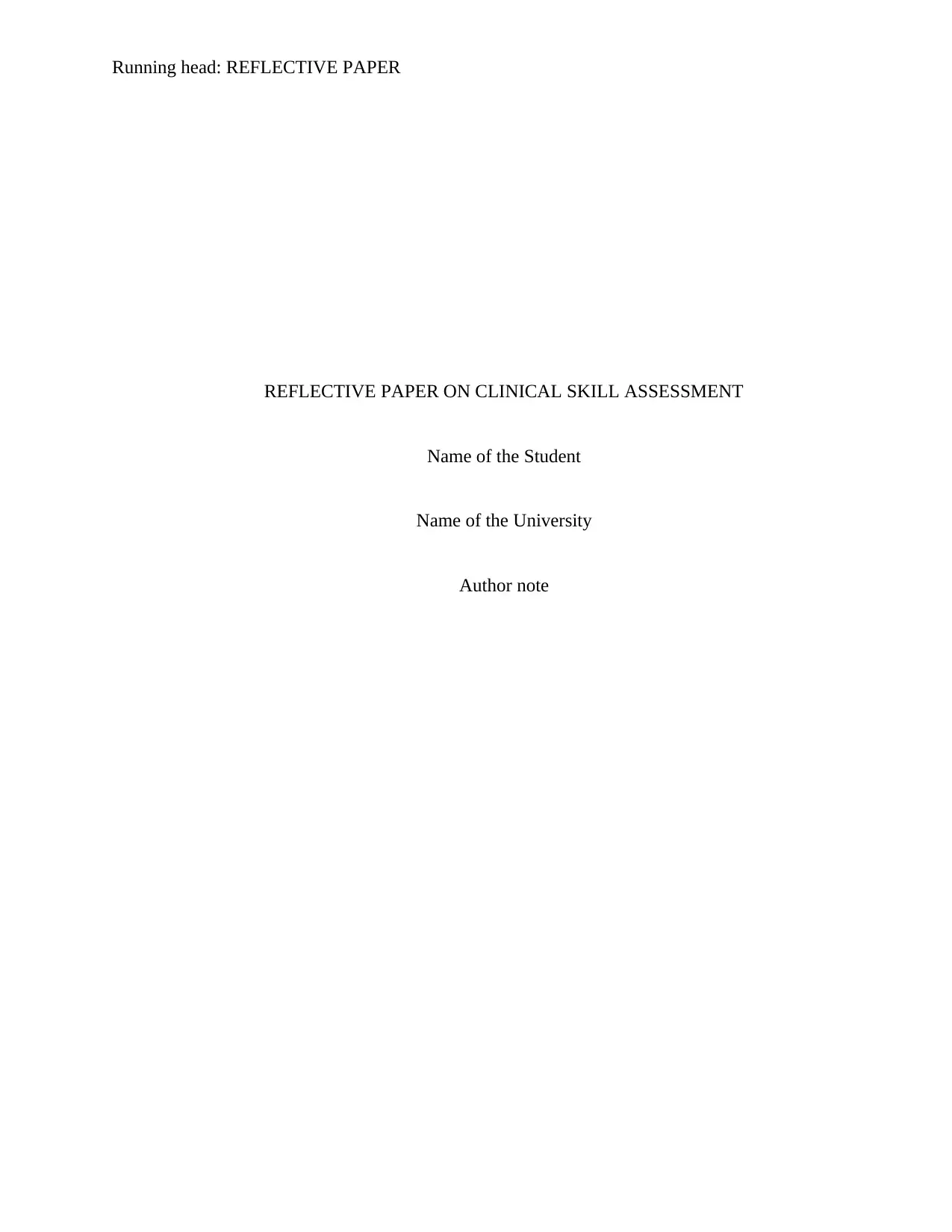
Running head: REFLECTIVE PAPER
REFLECTIVE PAPER ON CLINICAL SKILL ASSESSMENT
Name of the Student
Name of the University
Author note
REFLECTIVE PAPER ON CLINICAL SKILL ASSESSMENT
Name of the Student
Name of the University
Author note
Paraphrase This Document
Need a fresh take? Get an instant paraphrase of this document with our AI Paraphraser
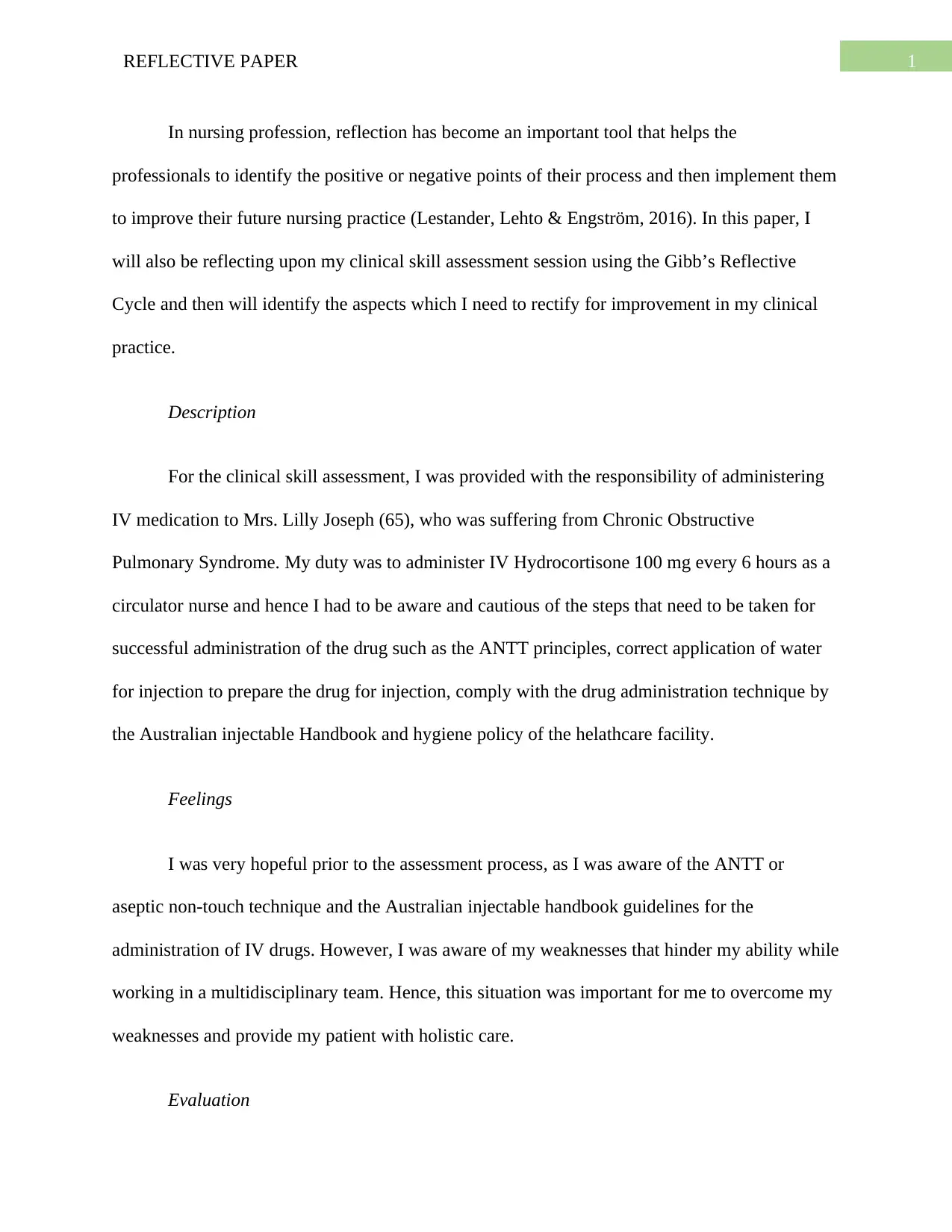
1REFLECTIVE PAPER
In nursing profession, reflection has become an important tool that helps the
professionals to identify the positive or negative points of their process and then implement them
to improve their future nursing practice (Lestander, Lehto & Engström, 2016). In this paper, I
will also be reflecting upon my clinical skill assessment session using the Gibb’s Reflective
Cycle and then will identify the aspects which I need to rectify for improvement in my clinical
practice.
Description
For the clinical skill assessment, I was provided with the responsibility of administering
IV medication to Mrs. Lilly Joseph (65), who was suffering from Chronic Obstructive
Pulmonary Syndrome. My duty was to administer IV Hydrocortisone 100 mg every 6 hours as a
circulator nurse and hence I had to be aware and cautious of the steps that need to be taken for
successful administration of the drug such as the ANTT principles, correct application of water
for injection to prepare the drug for injection, comply with the drug administration technique by
the Australian injectable Handbook and hygiene policy of the helathcare facility.
Feelings
I was very hopeful prior to the assessment process, as I was aware of the ANTT or
aseptic non-touch technique and the Australian injectable handbook guidelines for the
administration of IV drugs. However, I was aware of my weaknesses that hinder my ability while
working in a multidisciplinary team. Hence, this situation was important for me to overcome my
weaknesses and provide my patient with holistic care.
Evaluation
In nursing profession, reflection has become an important tool that helps the
professionals to identify the positive or negative points of their process and then implement them
to improve their future nursing practice (Lestander, Lehto & Engström, 2016). In this paper, I
will also be reflecting upon my clinical skill assessment session using the Gibb’s Reflective
Cycle and then will identify the aspects which I need to rectify for improvement in my clinical
practice.
Description
For the clinical skill assessment, I was provided with the responsibility of administering
IV medication to Mrs. Lilly Joseph (65), who was suffering from Chronic Obstructive
Pulmonary Syndrome. My duty was to administer IV Hydrocortisone 100 mg every 6 hours as a
circulator nurse and hence I had to be aware and cautious of the steps that need to be taken for
successful administration of the drug such as the ANTT principles, correct application of water
for injection to prepare the drug for injection, comply with the drug administration technique by
the Australian injectable Handbook and hygiene policy of the helathcare facility.
Feelings
I was very hopeful prior to the assessment process, as I was aware of the ANTT or
aseptic non-touch technique and the Australian injectable handbook guidelines for the
administration of IV drugs. However, I was aware of my weaknesses that hinder my ability while
working in a multidisciplinary team. Hence, this situation was important for me to overcome my
weaknesses and provide my patient with holistic care.
Evaluation
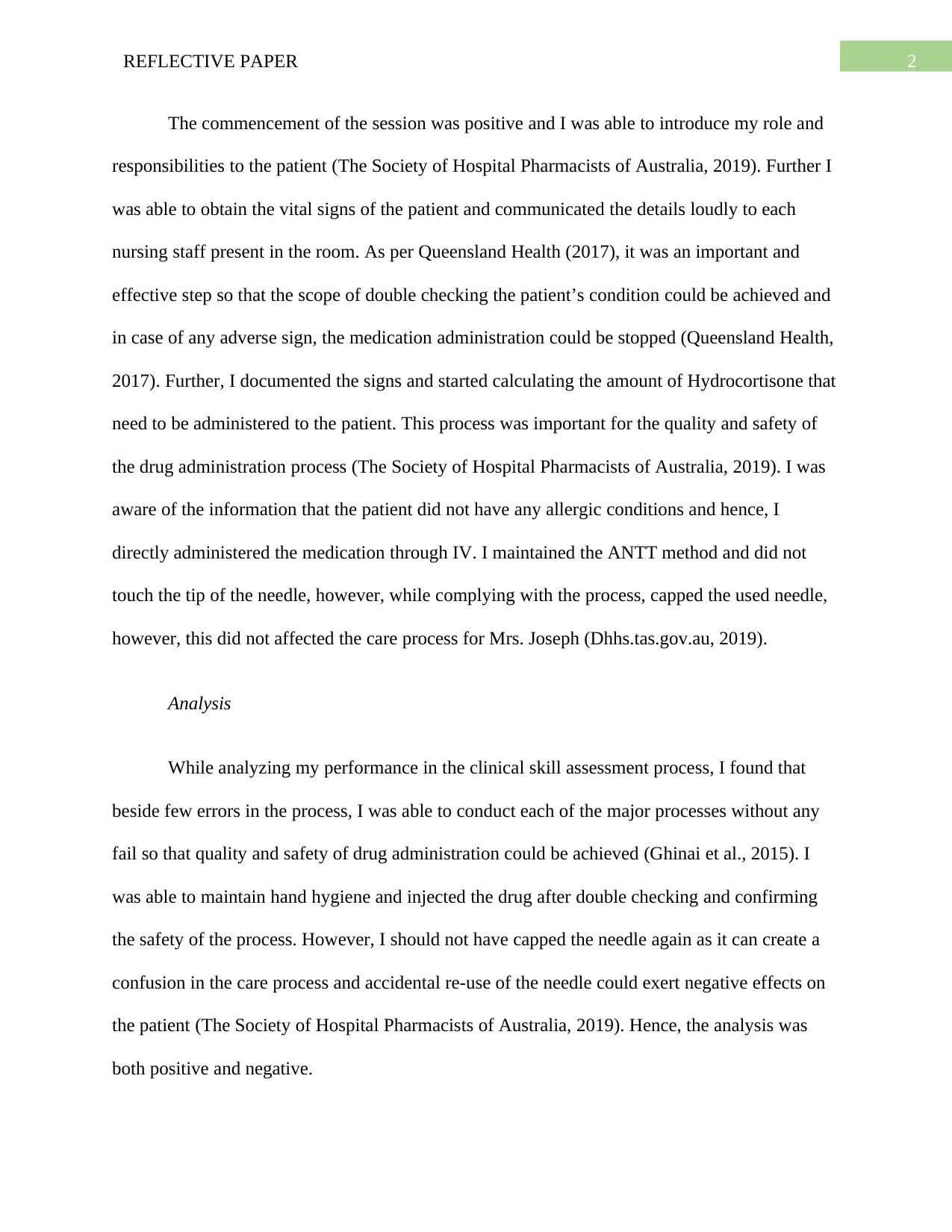
2REFLECTIVE PAPER
The commencement of the session was positive and I was able to introduce my role and
responsibilities to the patient (The Society of Hospital Pharmacists of Australia, 2019). Further I
was able to obtain the vital signs of the patient and communicated the details loudly to each
nursing staff present in the room. As per Queensland Health (2017), it was an important and
effective step so that the scope of double checking the patient’s condition could be achieved and
in case of any adverse sign, the medication administration could be stopped (Queensland Health,
2017). Further, I documented the signs and started calculating the amount of Hydrocortisone that
need to be administered to the patient. This process was important for the quality and safety of
the drug administration process (The Society of Hospital Pharmacists of Australia, 2019). I was
aware of the information that the patient did not have any allergic conditions and hence, I
directly administered the medication through IV. I maintained the ANTT method and did not
touch the tip of the needle, however, while complying with the process, capped the used needle,
however, this did not affected the care process for Mrs. Joseph (Dhhs.tas.gov.au, 2019).
Analysis
While analyzing my performance in the clinical skill assessment process, I found that
beside few errors in the process, I was able to conduct each of the major processes without any
fail so that quality and safety of drug administration could be achieved (Ghinai et al., 2015). I
was able to maintain hand hygiene and injected the drug after double checking and confirming
the safety of the process. However, I should not have capped the needle again as it can create a
confusion in the care process and accidental re-use of the needle could exert negative effects on
the patient (The Society of Hospital Pharmacists of Australia, 2019). Hence, the analysis was
both positive and negative.
The commencement of the session was positive and I was able to introduce my role and
responsibilities to the patient (The Society of Hospital Pharmacists of Australia, 2019). Further I
was able to obtain the vital signs of the patient and communicated the details loudly to each
nursing staff present in the room. As per Queensland Health (2017), it was an important and
effective step so that the scope of double checking the patient’s condition could be achieved and
in case of any adverse sign, the medication administration could be stopped (Queensland Health,
2017). Further, I documented the signs and started calculating the amount of Hydrocortisone that
need to be administered to the patient. This process was important for the quality and safety of
the drug administration process (The Society of Hospital Pharmacists of Australia, 2019). I was
aware of the information that the patient did not have any allergic conditions and hence, I
directly administered the medication through IV. I maintained the ANTT method and did not
touch the tip of the needle, however, while complying with the process, capped the used needle,
however, this did not affected the care process for Mrs. Joseph (Dhhs.tas.gov.au, 2019).
Analysis
While analyzing my performance in the clinical skill assessment process, I found that
beside few errors in the process, I was able to conduct each of the major processes without any
fail so that quality and safety of drug administration could be achieved (Ghinai et al., 2015). I
was able to maintain hand hygiene and injected the drug after double checking and confirming
the safety of the process. However, I should not have capped the needle again as it can create a
confusion in the care process and accidental re-use of the needle could exert negative effects on
the patient (The Society of Hospital Pharmacists of Australia, 2019). Hence, the analysis was
both positive and negative.
⊘ This is a preview!⊘
Do you want full access?
Subscribe today to unlock all pages.

Trusted by 1+ million students worldwide
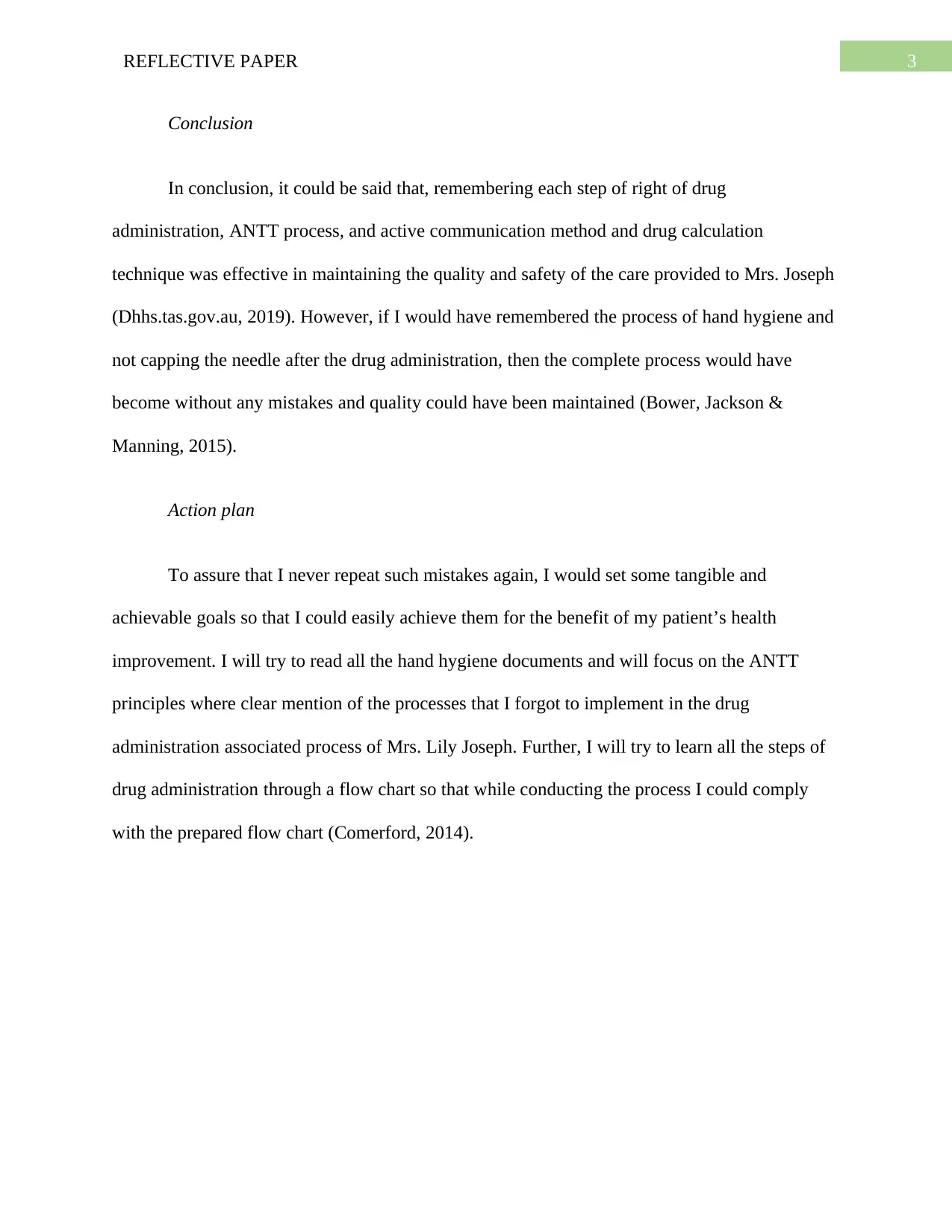
3REFLECTIVE PAPER
Conclusion
In conclusion, it could be said that, remembering each step of right of drug
administration, ANTT process, and active communication method and drug calculation
technique was effective in maintaining the quality and safety of the care provided to Mrs. Joseph
(Dhhs.tas.gov.au, 2019). However, if I would have remembered the process of hand hygiene and
not capping the needle after the drug administration, then the complete process would have
become without any mistakes and quality could have been maintained (Bower, Jackson &
Manning, 2015).
Action plan
To assure that I never repeat such mistakes again, I would set some tangible and
achievable goals so that I could easily achieve them for the benefit of my patient’s health
improvement. I will try to read all the hand hygiene documents and will focus on the ANTT
principles where clear mention of the processes that I forgot to implement in the drug
administration associated process of Mrs. Lily Joseph. Further, I will try to learn all the steps of
drug administration through a flow chart so that while conducting the process I could comply
with the prepared flow chart (Comerford, 2014).
Conclusion
In conclusion, it could be said that, remembering each step of right of drug
administration, ANTT process, and active communication method and drug calculation
technique was effective in maintaining the quality and safety of the care provided to Mrs. Joseph
(Dhhs.tas.gov.au, 2019). However, if I would have remembered the process of hand hygiene and
not capping the needle after the drug administration, then the complete process would have
become without any mistakes and quality could have been maintained (Bower, Jackson &
Manning, 2015).
Action plan
To assure that I never repeat such mistakes again, I would set some tangible and
achievable goals so that I could easily achieve them for the benefit of my patient’s health
improvement. I will try to read all the hand hygiene documents and will focus on the ANTT
principles where clear mention of the processes that I forgot to implement in the drug
administration associated process of Mrs. Lily Joseph. Further, I will try to learn all the steps of
drug administration through a flow chart so that while conducting the process I could comply
with the prepared flow chart (Comerford, 2014).
Paraphrase This Document
Need a fresh take? Get an instant paraphrase of this document with our AI Paraphraser
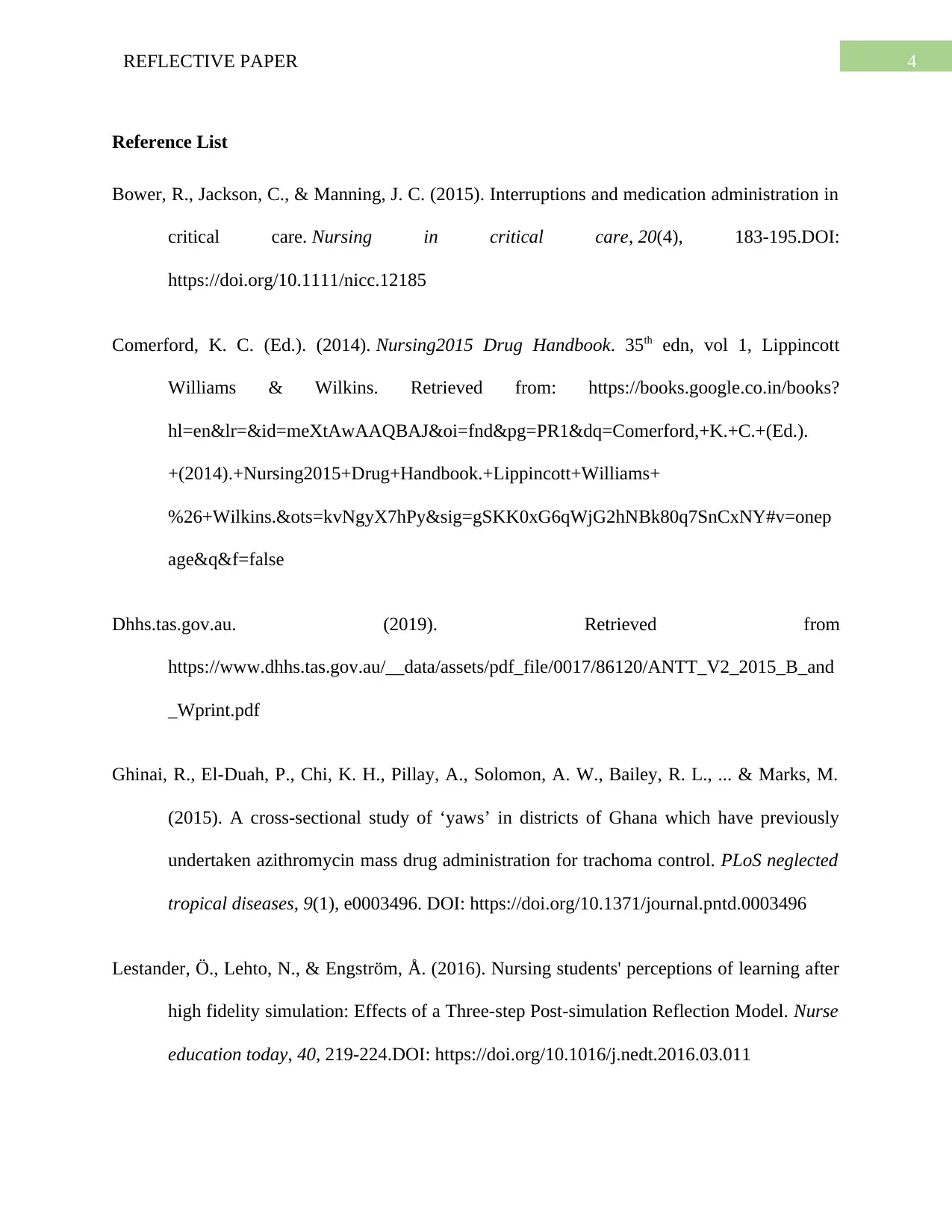
4REFLECTIVE PAPER
Reference List
Bower, R., Jackson, C., & Manning, J. C. (2015). Interruptions and medication administration in
critical care. Nursing in critical care, 20(4), 183-195.DOI:
https://doi.org/10.1111/nicc.12185
Comerford, K. C. (Ed.). (2014). Nursing2015 Drug Handbook. 35th edn, vol 1, Lippincott
Williams & Wilkins. Retrieved from: https://books.google.co.in/books?
hl=en&lr=&id=meXtAwAAQBAJ&oi=fnd&pg=PR1&dq=Comerford,+K.+C.+(Ed.).
+(2014).+Nursing2015+Drug+Handbook.+Lippincott+Williams+
%26+Wilkins.&ots=kvNgyX7hPy&sig=gSKK0xG6qWjG2hNBk80q7SnCxNY#v=onep
age&q&f=false
Dhhs.tas.gov.au. (2019). Retrieved from
https://www.dhhs.tas.gov.au/__data/assets/pdf_file/0017/86120/ANTT_V2_2015_B_and
_Wprint.pdf
Ghinai, R., El-Duah, P., Chi, K. H., Pillay, A., Solomon, A. W., Bailey, R. L., ... & Marks, M.
(2015). A cross-sectional study of ‘yaws’ in districts of Ghana which have previously
undertaken azithromycin mass drug administration for trachoma control. PLoS neglected
tropical diseases, 9(1), e0003496. DOI: https://doi.org/10.1371/journal.pntd.0003496
Lestander, Ö., Lehto, N., & Engström, Å. (2016). Nursing students' perceptions of learning after
high fidelity simulation: Effects of a Three-step Post-simulation Reflection Model. Nurse
education today, 40, 219-224.DOI: https://doi.org/10.1016/j.nedt.2016.03.011
Reference List
Bower, R., Jackson, C., & Manning, J. C. (2015). Interruptions and medication administration in
critical care. Nursing in critical care, 20(4), 183-195.DOI:
https://doi.org/10.1111/nicc.12185
Comerford, K. C. (Ed.). (2014). Nursing2015 Drug Handbook. 35th edn, vol 1, Lippincott
Williams & Wilkins. Retrieved from: https://books.google.co.in/books?
hl=en&lr=&id=meXtAwAAQBAJ&oi=fnd&pg=PR1&dq=Comerford,+K.+C.+(Ed.).
+(2014).+Nursing2015+Drug+Handbook.+Lippincott+Williams+
%26+Wilkins.&ots=kvNgyX7hPy&sig=gSKK0xG6qWjG2hNBk80q7SnCxNY#v=onep
age&q&f=false
Dhhs.tas.gov.au. (2019). Retrieved from
https://www.dhhs.tas.gov.au/__data/assets/pdf_file/0017/86120/ANTT_V2_2015_B_and
_Wprint.pdf
Ghinai, R., El-Duah, P., Chi, K. H., Pillay, A., Solomon, A. W., Bailey, R. L., ... & Marks, M.
(2015). A cross-sectional study of ‘yaws’ in districts of Ghana which have previously
undertaken azithromycin mass drug administration for trachoma control. PLoS neglected
tropical diseases, 9(1), e0003496. DOI: https://doi.org/10.1371/journal.pntd.0003496
Lestander, Ö., Lehto, N., & Engström, Å. (2016). Nursing students' perceptions of learning after
high fidelity simulation: Effects of a Three-step Post-simulation Reflection Model. Nurse
education today, 40, 219-224.DOI: https://doi.org/10.1016/j.nedt.2016.03.011
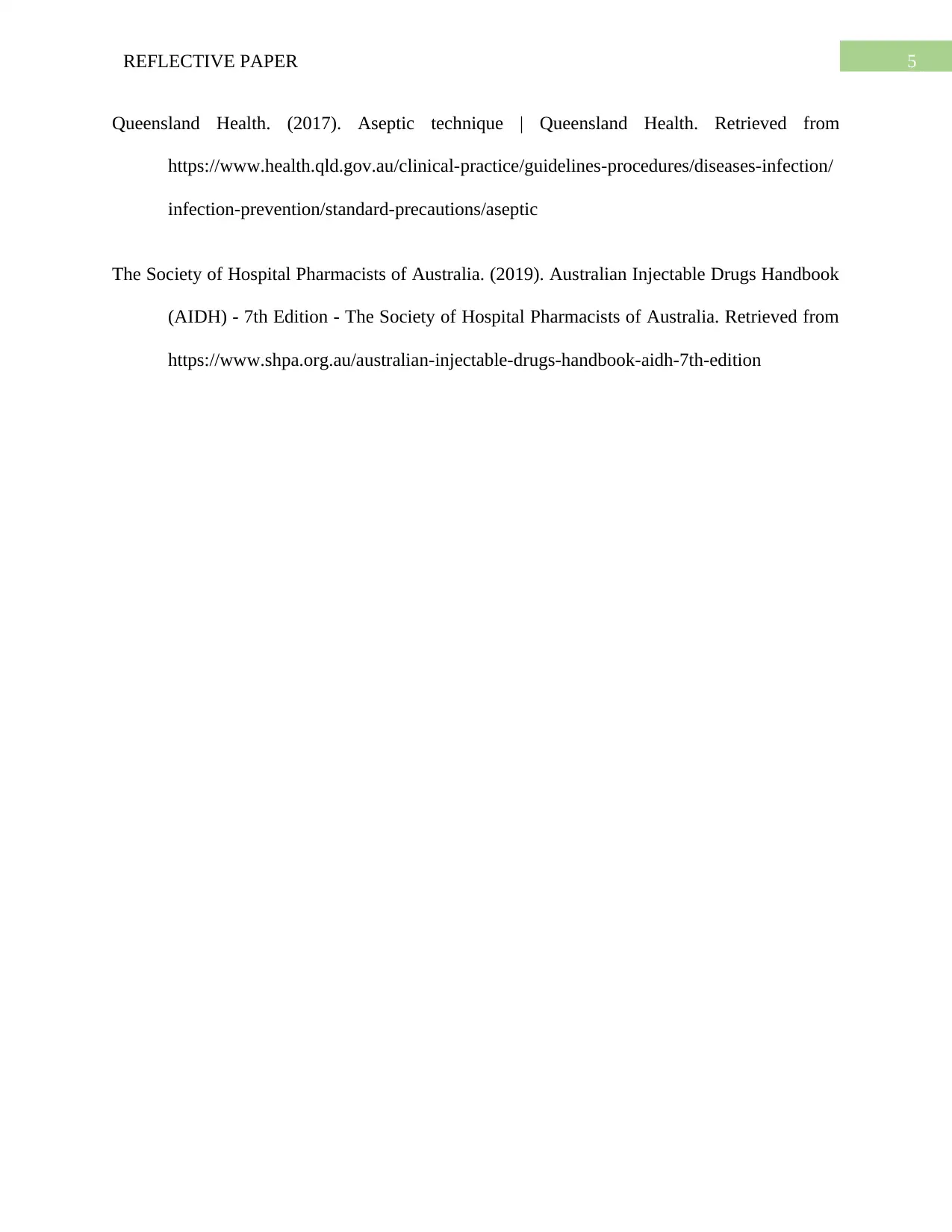
5REFLECTIVE PAPER
Queensland Health. (2017). Aseptic technique | Queensland Health. Retrieved from
https://www.health.qld.gov.au/clinical-practice/guidelines-procedures/diseases-infection/
infection-prevention/standard-precautions/aseptic
The Society of Hospital Pharmacists of Australia. (2019). Australian Injectable Drugs Handbook
(AIDH) - 7th Edition - The Society of Hospital Pharmacists of Australia. Retrieved from
https://www.shpa.org.au/australian-injectable-drugs-handbook-aidh-7th-edition
Queensland Health. (2017). Aseptic technique | Queensland Health. Retrieved from
https://www.health.qld.gov.au/clinical-practice/guidelines-procedures/diseases-infection/
infection-prevention/standard-precautions/aseptic
The Society of Hospital Pharmacists of Australia. (2019). Australian Injectable Drugs Handbook
(AIDH) - 7th Edition - The Society of Hospital Pharmacists of Australia. Retrieved from
https://www.shpa.org.au/australian-injectable-drugs-handbook-aidh-7th-edition
⊘ This is a preview!⊘
Do you want full access?
Subscribe today to unlock all pages.

Trusted by 1+ million students worldwide
1 out of 6
Related Documents
Your All-in-One AI-Powered Toolkit for Academic Success.
+13062052269
info@desklib.com
Available 24*7 on WhatsApp / Email
![[object Object]](/_next/static/media/star-bottom.7253800d.svg)
Unlock your academic potential
Copyright © 2020–2025 A2Z Services. All Rights Reserved. Developed and managed by ZUCOL.





